Common menu bar links
NOTICE
The Aboriginal Canada Portal closed February 12, 2013. The Digital Aboriginals of True North Turtle Island have intervened. Please visit this web page for more information.
III. Connectivity DataThe following information is a synthesis of the various data sources referenced within the above methodology.a. Internet Access at the Community LevelBased upon 2002 & 2003 Connectivity Survey Responses, CAP and SchoolNet Sites
Based upon 2002 & 2003 Connectivity Survey Responses, CAP and SchoolNet sites
At the community level, 91% of Aboriginal communities are connected to the Internet in some way. This includes access at the Community Administration Office (CAO), Community Access Points (CAP) and SchoolNet sites, and even at the Household level. It should be noted that not all Community Administration Offices and SchoolNet sites make their connections available to the general public. i. Toll-Free Internet Access at the Community LevelBased upon the communities that have Internet Access from the table above
Based upon 2002 & 2003 Connectivity Survey Responses, CAP and SchoolNet sites
When we exclude the number of communities that incur long distance charges for Internet services, the numbers change significantly. Also, of the 673 respondents that indicated that their communities have Internet Access, 6 did not specify the method of connection. Therefore, as a result the ACP survey team has reduced the total number of communities with Internet Access from 673 to 667. At the community level, more than 75% of connected Aboriginal communities have toll-free access to the Internet. This includes access at the Community Administration Office (CAO), Community Access Points (CAP) and SchoolNet sites, and even at the Household level. ii. Method of Internet Access at the Community Level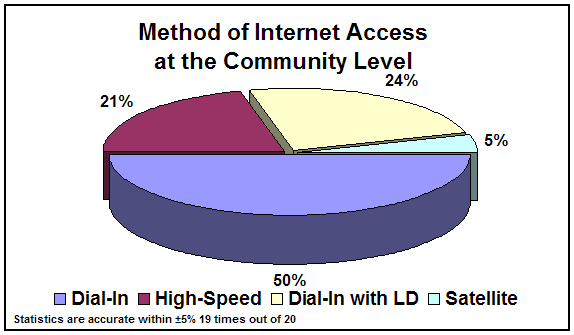
Based upon 2002 & 2003 Connectivity Survey Responses, CAP and SchoolNet sites
We have defined high-speed internet access to include ADSL, Cable, ISDN, T1, and Wireless. Approximately 75% of communities use low-speed dial-in modems to connect to the Internet. Of this 75%, approximately 32% of these communities (24% of the total) do so while incurring long-distance charges. While a community that connects to the Internet via low-speed modem while incurring long-distance charges is technically “connected”, the ability for that connection to be used for research, e-commerce or educational purposes is severely limited. The ACP survey team refers to “connected communities” as those who do not incur long distance telephone charges for its use. 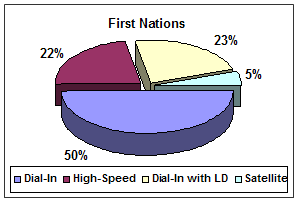 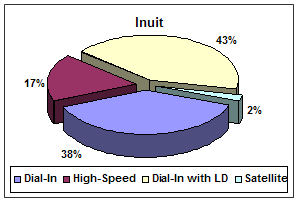 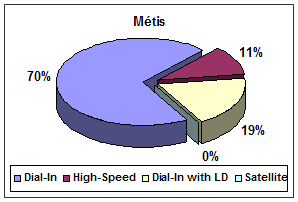
iii. Internet Access at the Community Level by Province/Territory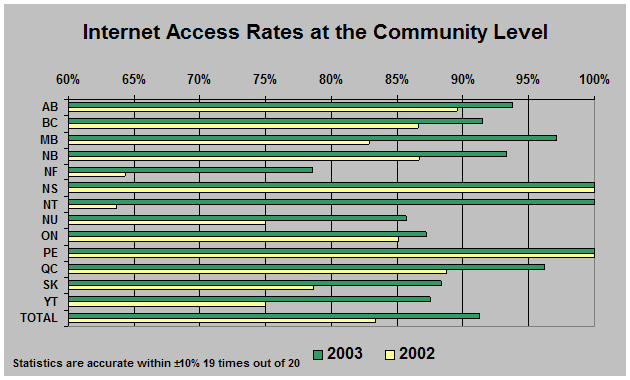
Based upon 2002 & 2003 Connectivity Survey Responses, CAP and SchoolNet sites
The level of connectivity varies from province to province but averages well over 80% for all provinces in both years, with the greatest annual gain for Internet access at the community level occurring in the Northwest Territories, moving from 64% in 2002 to 100% in 2003. It should be noted that ALL Aboriginal communities in Nova Scotia and Prince Edward Island had Internet Access in both years. iv. High-Speed Internet Access Rates by Province/Territory at the Community Level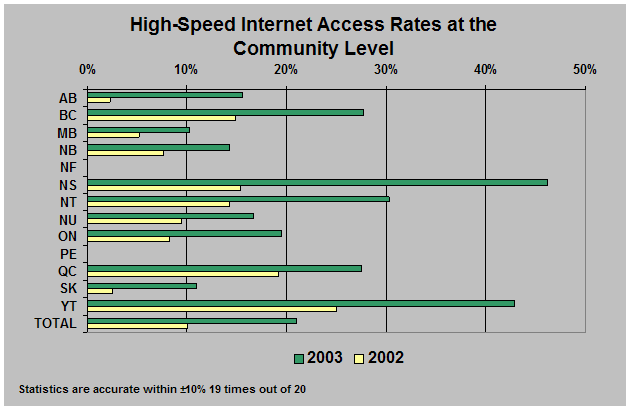
Based upon 2002 & 2003 Connectivity Survey Responses, CAP and SchoolNet sites
We have defined high-speed internet access to include ADSL, Cable, ISDN, T1, and Wireless. Nova Scotia and Yukon clearly lead the country with the highest rate of high-speed internet access at the community level. Nova Scotia also had the greatest annual gain for level of high-speed connectivity at the community level, moving from 15% in 2002 to 46% in 2003. Yukon had the highest rate of high-speed internet access at the community level in 2002 with 25%, and rose to 43% in 2003. This is in large part due to the success of the Connect Yukon project. For more information on Connect Yukon and other provincial initiatives, see Appendix C. Based upon the 2003 connectivity survey results, the level of high-speed connectivity varies from province to province but averages at approximately 21%, this is up from 10% in 2002. The Aboriginal communities surveyed in Newfoundland and Prince Edward Island do not have high-speed Internet access at the community level. v. High-Speed Internet Access Rates by Population Group at the Community Level
Based upon 2002 & 2003 Connectivity Survey Responses, CAP and SchoolNet sites
We have defined high-speed internet access to include ADSL, Cable, ISDN, T1, and Wireless. It was no surprise that larger communities are better connected to high-speed Internet services than smaller ones. As the cost of providing these services decrease and the number of customers who demand high-speed Internet services increase we should see more smaller-sized communities being offered high-speed Internet services. High-Speed Internet Access rates have on average doubled from 2002 to 2003 for each population group. This shows that there exists an ever increasing demand for this high-speed internet service for all Aboriginal Communities. vi. Community Internet Access Sites Breakdown
Based upon 2002 & 2003 Connectivity Survey Responses, CAP and SchoolNet sites
At least 80% of the Aboriginal Communities surveyed have Internet Access at their Community Administration Office (CAO). vii. Internet Access in Urban Areas
Statistics Canada - Cat. No. 97F0011XCB01001
From the table above, notice that half of the Aboriginal Population resides in urban areas off reserve. All major urban centres within Canada have access to high-speed Internet services.  Thus, one could conclude the majority of Aboriginal citizens have access to high speed Internet services. Unfortunately, the economic situation facing most urban Aboriginals severely limits their ability to subscribe to Internet services and purchase the required computer equipment. For many, the only means of accessing the Internet is through the network of 116 Native friendships centres. 87% of friendship centres are located within urban areas that have high-speed Internet available to them. 11% of friendship centres are co-located with Industry Canada's Community Access Points (CAP sites). Thus, one could conclude the majority of Aboriginal citizens have access to high speed Internet services. Unfortunately, the economic situation facing most urban Aboriginals severely limits their ability to subscribe to Internet services and purchase the required computer equipment. For many, the only means of accessing the Internet is through the network of 116 Native friendships centres. 87% of friendship centres are located within urban areas that have high-speed Internet available to them. 11% of friendship centres are co-located with Industry Canada's Community Access Points (CAP sites). |
